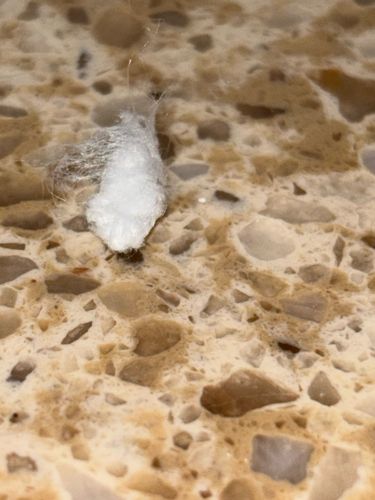Mealybug (specifically, a female or egg sac)
Scientific Name: Various species within the Pseudococcidae family (e.g., Planococcus citri - Citrus Mealybug, Pseudococcus longispinus - Longtailed Mealybug). Without clearer morphological details, a precise species identification is difficult.
Order & Family: Hemiptera (Order), Pseudococcidae (Family)
Size: Typically 1-4 mm for adult females, though the fluffy waxy covering can make them appear larger. The object in the image appears to be several millimeters in size.

Natural Habitat
Found on various parts of plants, including leaves, stems, roots, and fruits. They are common in greenhouses, indoor plants, and warmer outdoor climates. The image shows it on a countertop, suggesting it might have been dislodged from a nearby plant.
Diet & Feeding
Plant sap (phloem), from a wide variety of host plants including ornamental plants, fruits, and vegetables.
Behavior Patterns
Mealybugs are typically slow-moving or sessile, especially the females. They feed by inserting their stylets into plant tissue and sucking out sap. The waxy coating provides protection from predators and desiccation. Females lay eggs in a waxy ovisac, often on the underside of leaves or in crevices.
Risks & Benefits
Risks: Mealybugs are significant agricultural and horticultural pests. They cause damage by sucking sap, leading to stunted growth, yellowing, leaf drop, and even plant death. They also excrete honeydew, a sticky substance that promotes the growth of sooty mold, which can reduce photosynthesis and aesthetic value. Benefits: No significant benefits are typically associated with mealybugs; they are primarily considered pests.
Identified on: 8/23/2025